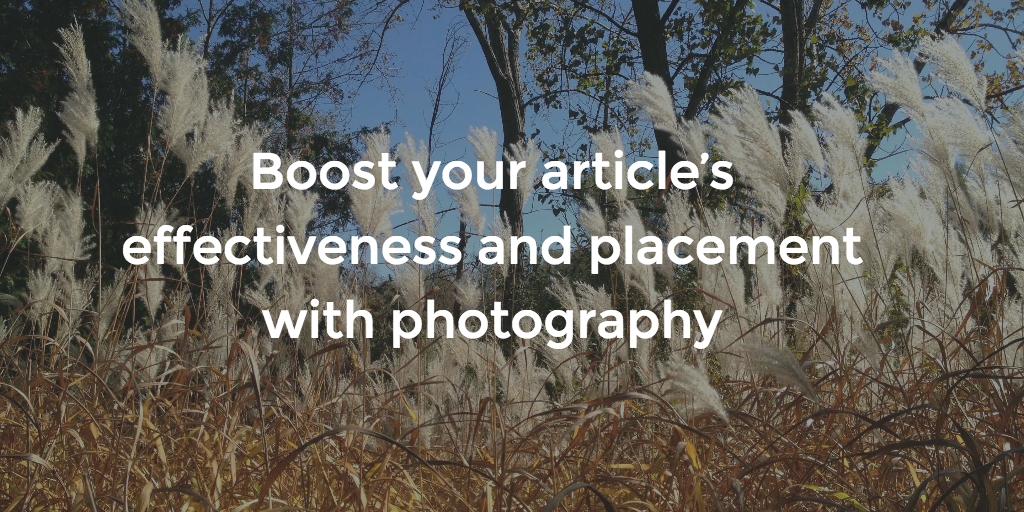But if it were that easy, everyone would be doing it.
I’ve talked about some of the points on how to publish articles in client-read publications in blog post #18. One aspect, I’ve touched on lightly is the role of photography and other graphics play in the process of getting published.
You might puzzle, “Why do I need photographs to go with my article?” The reason: editors want them, and since editors are the kings and queens of their own domain, it is a great idea to give them what they want. And not what you want.
Editors want pictures because they help to break up the text and add visual appeal to the page. In many publications, they’ll devote most of a two-page spread article to a photograph, with only a few paragraphs of actual text. The article continues on subsequent pages. Many times, I’ve had pictures that weren’t particularly good, but were given pride of place in a publication, sometimes on the cover.
Editors tend to give better, more, and faster placement to articles that have good images to go with them.
It’s the same with online posting – most editors of online publications also want at least one photograph to go with the article. Some of the guest blogging I’ve done has found that having a picture is not just a nice-to-have to boost readership, it’s a requirement.
Why most editors hate stock photography
You may be thinking, “No problem. Just go to iStock or a free image site.” Well, for editors, that is a problem. Faced with a .jpg or .png file of unknown progeny, their warning bells go off.
Every publisher has heard of a colleague who was visited by lawyers’ letters and a world of legal pain when a “free” image turns out to have had actual owners. Those owners often retain legal counsel who scan the web for illegally used images, and then initiate legal action in hopes of getting a payout. If the editor relied on you for assurance that the image was free of legal entanglements, you might get sucked into the legal morass too.
I remember the editor of Content Marketing Institute, for whom I’ve guessed blogged at times, requiring me to send her an e-mail assuring her that I owned the rights to the image I was offering along with my guest post.
Stock imagery has probably been around since the first hazy images of the 1860s. I can recall thick printed books, carefully housed on bookshelves in art departments, with photographs that could be purchased under various rights arrangements. The new ease of sharing and sending images as electronic files, and website display, has rendered such books an anachronism.
But the images-for-purchase business is booming. It’s easy for you to buy rights to images for use on your own newsletter, blog, website or other publication. But that doesn’t mean that an editor of a print publication, with tens of thousands in circulation, will be able to get by on the license you bought online.
Why it’s good to have your own images
Sometimes on vacation, my Other Half gets a bit impatient (well, maybe more than a bit) because I’m stuck taking photographs of something she’d deem unappealing. Maybe it’s a herd of wind turbines, a hydro-electric dam, or an open-pit mine. Maybe a municipal solid-waste landfill or a solar farm. I’m taking those images because I often ghost-write articles for my clients on those topics.
I took some pictures of an open-pit mine one day after a fresh snowfall, when the massive scar in the earth looked almost pretty, and I’ve used those images many, many times. You can do this too.
You don’t even need a real camera. A standard smartphone can be equipped with extra lenses to give a telephoto or wide-angle approach to the scene. And it’s easy to edit, crop and retouch images using garden-variety software like Apple’s Photo program.
The wonderful thing about these images is that they’re yours. That means no legal hassles, and you can assure the editor that you took the pictures and that it’s safe to use them.
What to watch for in the images you use
High resolution: the resolution required for print is higher than for online use, where images are often lighted up to speed loading times. An image for print should be at least 1 MB in size.
Copyright elements: You’re best to keep corporate logos and other copyright elements out of the pictures you use – the risk of legal action is slight, but it’s better safe than sorry.
Take vertical as well as horizontal images, because the space that the editor needs to fill might be vertical or horizontal. Having said that, most image spaces on online media are horizontal, maybe square.
Provide captions. Even if the picture is of only tangential relation to the article, a caption can help to underline the message of your article.


